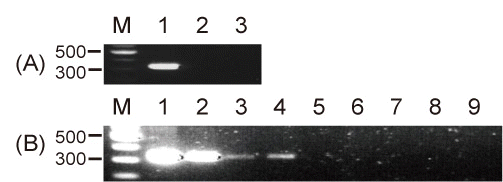1. Sachs DH, Sykes M, Robson SC, Cooper DK. Xenotransplantation. Adv Immunol. 2001; 79:129–223.

2. Patience C, Takeuchi Y, Weiss RA. Infection of human cells by an endogenous retrovirus of pigs. Nat Med. 1997; 3:282–286.

3. Tacke SJ, Kurth R, Denner J. Porcine endogenous retroviruses inhibit human immune cell function: risk for xenotransplantation? Virology. 2000; 268:87–93.

4. Oldmixon BA, Wood JC, Ericsson TA, Wilson CA, White-Scharf ME, Andersson G, Greenstein JL, Schuurman HJ, Patience C. Porcine endogenous retrovirus transmission characteristics of an inbred herd of miniature swine. J Virol. 2002; 76:3045–3048.

5. Valdes-Gonzalez R, Dorantes LM, Bracho-Blanchet E, Rodríguez-Ventura A, White DJ. No evidence of porcine endogenous retrovirus in patients with type 1 diabetes after long-term porcine islet xenotransplantation. J Med Virol. 2010; 82:331–334.

6. Tacke SJ, Specke V, Denner J. Differences in release and determination of subtype of porcine endogenous retroviruses produced by stimulated normal pig blood cells. Intervirology. 2003; 46:17–24.

7. Kim HI, Lee SY, Jin SM, Kim KS, Yu JE, Yeom SC, Yoon TW, Kim JH, Ha J, Park CG, Kim SJ. Parameters for successful pig islet isolation as determined using 68 specific-pathogen-free miniature pigs. Xenotransplantation. 2009; 16:11–18.

8. Deng Y, Tuch BE, Rawlinson WD. Transmission of porcine endogenous retroviruses in severe combined immunodeficient mice xenotransplanted with fetal porcine pancreatic cells. Transplantation. 2000; 70:1010–1016.
9. Armstrong JA, Porterfield JS, De Madrid AT. C-type virus particles in pig kidney cell lines. J Gen Virol. 1971; 10:195–198.

10. Le Tissier P, Stoye JP, Takeuchi Y, Patience C, Weiss RA. Two sets of human-tropic pig retrovirus. Nature. 1997; 389:681–682.

11. Takeuchi Y, Patience C, Magre S, Weiss RA, Banerjee PT, Le Tissier P, Stoye JP. Host range and interference studies of three classes of pig endogenous retrovirus. J Virol. 1998; 72:9986–9991.

12. Martin U, Winkler ME, Id M, Radecke H, Arseniev L, Grotelüschen R, Simon AR, Steinhoff G. Transmission of pig endogenous retrovirus to primary human cells. Transplant Proc. 2000; 32:115–117.

13. Martin U, Winkler ME, Id M, Radeke H, Arseniev L, Takeuchi Y, Simon AR, Patience C, Haverich A, Steinhoff G. Productive infection of primary human endothelial cells by pig endogenous retrovirus (PERV). Xenotransplantation. 2000; 7:138–142.

14. Specke V, Rubant S, Denner J. Productive infection of human primary cells and cell lines with porcine endogenous retroviruses. Virology. 2001; 285:177–180.

15. Wilson CA, Wong S, Muller J, Davidson CE, Rose TM, Burd P. Type C retrovirus released from porcine primary peripheral blood mononuclear cells infects human cells. J Virol. 1998; 72:3082–3087.

16. Czauderna F, Fischer N, Boller K, Kurth R, Tönjes RR. Establishment and characterization of molecular clones of porcine endogenous retroviruses replicating on human cells. J Virol. 2000; 74:4028–4038.

17. Krach U, Fischer N, Czauderna F, Tönjes RR. Comparison of replication-competent molecular clones of porcine endogenous retrovirus class A and class B derived from pig and human cells. J Virol. 2001; 75:5465–5472.

18. Tönjes RR, Czauderna F, Fischer N, Krach U, Boller K, Chardon P, Rogel-Gaillard C, Niebert M, Scheef G, Werner A, Kurth R. Molecularly cloned porcine endogenous retroviruses replicate on human cells. Transplant Proc. 2000; 32:1158–1161.

19. Huthoff H, Towers GJ. Restriction of retroviral replication by APOBEC3G/F and TRIM5alpha. Trends Microbiol. 2008; 16:612–619.
20. Switzer WM, Michler RE, Shanmugam V, Matthews A, Hussain AI, Wright A, Sandstrom P, Chapman LE, Weber C, Safley S, Denny RR, Navarro A, Evans V, Norin AJ, Kwiatkowski P, Heneine W. Lack of cross-species transmission of porcine endogenous retrovirus infection to nonhuman primate recipients of porcine cells, tissues, or organs. Transplantation. 2001; 71:959–965.
21. Kim JH, Choi EY, Jung ES, Kwon Y, Lee DS, Hwang DY, Hwang ES. Characterization of clones of human cell line infected with porcine endogenous retrovirus (PERV) from porcine cell line, PK-15. Infect Chemother. 2009; 41:1–8.

22. Yu P, Zhang L, Li SF, Li YP, Cheng JQ, Lu YR, Bu H. Long-term effects on HEK-293 cell line after co-culture with porcine endogenous retrovirus. Transplant Proc. 2005; 37:496–499.

23. Yu P, Zhang L, Li SF, Cheng JQ, Lu YR, Zeng YZ, Li YP, Bu H. A rapid method for detection of the copy number of porcine endogenous retrovirus in swine. J Rapid Methods Autom Microbiol. 2007; 15:199–205.






 PDF
PDF ePub
ePub Citation
Citation Print
Print


 XML Download
XML Download